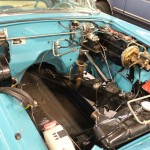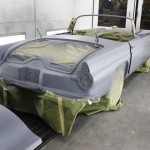1956 Ford Thunderbird (Teal)
The Thunderbird (“T-Bird”), is an automobile manufactured by the Ford Motor Company in the United States over eleven model generations from 1955 through 2005. When introduced, it created the market niche eventually known as the personal luxury car.
Explore the Project Galleries
Arrival
Disassembly
Strip & Metal Fab
Mechanical
Body & Paint
Detail & Trim
Finish
The domestic manufacturers didn’t make compacts or subcompacts, SUVs were unheard of, and they didn’t make sports cars until Chevrolet introduced the Corvette in 1953. And they didn’t make a “personal luxury car” until Ford introduced the 1955 Thunderbird.
What the first Thunderbird delivered was style and sophistication that used to be available only from expensive imports like Mercedes-Benz and Jaguar with the simple construction and reasonable price tag of a Ford. What that first two-seat T-Bird didn’t have was room enough for at least two more passengers. And it was when that room was added that the T-Bird really took flight.
First Generation (1955-1957): Classic Two-Seat Thunderbirds
If Chevrolet hadn’t introduced the 1953 Corvette it’s likely that Ford never would have felt compelled to develop the Thunderbird in response. But though the T-Bird was a response to it, Ford’s two-seater was a distinctly different machine from GM’s plastic-bodied sports car.
First of all, the Thunderbird’s body, like that of all other Fords, was made of steel. Second, the Thunderbird was available solely with a V8 engine unlike the Corvette which started life with a straight six and only added the V8 as an option for 1955. And third, the Thunderbird wasn’t trying very hard to pretend it was a sports car.
Like the Corvette, however, development of the Thunderbird was rapid. The development program, according to an internal corporate memo, was launched by Ford in February of 1953 just a month after the Corvette prototype’s debut at the General Motors Motorama. In much the same way that GM developed the Corvette using standard Chevrolet mechanical pieces, the Thunderbird used very familiar elements. The frame was basically a cut-down version of the standard Ford frame with a 102-inch wheelbase identical to that of the Corvette and the 292-cubic-inch OHV V8 came straight from Mercury. The styling also carried over then-current Ford themes including the egg-crate grille, single headlamps faired into the front fenders, single circle taillights and stubby tailfins.
But while the standard Fords looked somewhat bulbous and awkward, the T-Bird was sleek, athletic and sophisticated. The half-covered rear wheel openings and whitewall tires didn’t say much about performance back in ’55, but the simulated air scoop on the hood, the engine-turned-dashboard and 150-mph speedometer all hinted that there was more aboard than in any normal Ford.
“Ford prefers to call it a ‘personal car,'” explained Motor Trend back then. “The thinking behind this, as brought out in a discussion with W.R. Burnett, chief passenger car engineer for Ford, is that ‘although the Thunderbird has the performance and attributes of most sports cars, management also felt that it should have a few more comforts to make it more appealing to a wider segment of the public.'”
All the original T-Birds were convertibles with a standard fiberglass hardtop (the canvas retractable top was actually an option). Breathing through a four-barrel carburetor, the 292 V8 was rated at 193 horsepower when backed by the standard three-speed manual transmission. Opting for the three-speed “Ford-O-Matic” three-speed automatic transmission brought with it a leap in engine output to 198 hp. The suspension was just as simple as that under any other Ford with the independent front suspension using coil springs and the solid rear axle on leaf springs. Braking was by a drum inboard of each oversize 15-inch wheel.
The Thunderbird went on sale October 22, 1954, and quickly overwhelmed the Corvette in sales volume. Ford had thought it would sell about 10,000 examples that first year, but found itself unable to keep up with demand and eventually knocked out 16,155 examples during the debut model year (production ran deep into September of ’55 when the 1956 model Fords were already in showrooms). That was more than five times the number of Corvettes Chevrolet built that year — and all this despite a price tag that started at $2,695 but could run easily past $3,800 with options.
With such a solid start, Ford saw little reason to screw with the Thunderbird formula when it was time to develop the 1956 models. A “Continental Kit” was now standard that mounted the spare tire outboard of the car on the rear bumper. This cleared up more space for luggage in the shallow trunk, but made accessing that trunk more difficult because cargo now needed to be hoisted around the spare tire. The other big change was the addition of optional circular “portholes” in the fiberglass roof that eliminated some serious blind spots in the car. There were also new vents in the front fenders to bleed off heat before it cooked the driver’s and passenger’s feet into hams in Florsheims. Vent wing windows were also new and the car could be had in more colors and some two-tone paint schemes.
But the best news was a new optional 312-cubic-inch version of Ford’s OHV V8 that was rated at a throaty 215 hp when inhaling through a four-barrel carb and backed by an overdrive manual transmission. That output swelled to 225 hp when the 312 was mated to the Ford-O-Matic. Output of the standard 292 V8 rose to an even 200 hp and it was only available with the three-speed manual transmission.
With the Thunderbird novelty wearing off slightly, Ford sold 15,631 of the ’56 model.
Read more about the Ford Thunderbird at: http://www.edmunds.com/ford/thunderbird/history.html

































